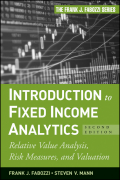
Introduction to fixed income analytics: relative value analysis, risk measures and valuation
Fabozzi, Frank J.
Mann, Steven V.
A comprehensive introduction to the key concepts of fixed income analytics The First Edition of Introduction to Fixed Income Analytics skillfully covered the fundamentals of this discipline and was the first book to feature Bloombergscreens in examples and illustrations. Since publication over eight years ago, the markets have experienced cathartic change. That's why authors Frank Fabozzi and Steven Mann have returned with a fully updated Second Edition. This reliable resource reflects current economic conditions, and offers additional chapters on relative value analysis, value-at-risk measures and information on instruments like TIPS (treasury inflation protected securities). * Offers insights into value-at-risk, relative value measures, convertible bond analysis, and much more * Includes updated charts and descriptions using Bloomberg screens* Covers important analytical concepts used by portfolio managers Understanding fixed-income analytics is essential in today's dynamic financial environment. The Second Edition of Introduction to Fixed Income Analytics will help you build a solid foundation in this field INDICE: Preface. About the Authors. CHAPTER 1 Time Value of Money. Future Value of a Single Cash Flow. Present Value of a Single Cash Flow. Compounding/Discounting When Interest Is Paid More Than Annually. Future and Present Values of an Ordinary Annuity. Yield (Internal Rate of Return). Concepts Presented in this Chapter. Appendix: Compounding and Discounting in Continuous Time. Questions. CHAPTER 2 Yield Curve Analysis: Spot Rates and Forward Rates. A Bond Is a Package of Zero-Coupon Instruments. Theoretical Spot Rates. Forward Rates.Dynamics of the Yield Curve. Concepts Presented in this Chapter. Questions. CHAPTER 3 Day Count Conventions and Accrued Interest. Day Count Conventions. Computing the Accrued Interest. Concepts Presented in this Chapter. Questions. CHAPTER 4 Valuation of Option-Free Bonds. General Principles of Valuation. Determining a Bond's Value. The Price/Discount Rate Relationship. Time Path of Bond. Valuing a Zero-Coupon Bond. Valuing a Bond Between Coupon Payments. Traditional Approach to Valuation. The Arbitrage-Free Valuation Approach. Concepts Presented in this Chapter. Questions. CHAPTER 5 Yield Measures. Sources of Return. Traditional Yield Measures. Yield to Call. Yield to Put. Yield to Worst. Cash Flow Yield. Portfolio Yield Measures. Yield Measures for U.S. Treasury Bills. Yield Spread Measures Relative to a Spot Rate Curve. Concepts Presented in this Chapter. Appendix: Mathematics of the Internal Rate of Return. Questions.CHAPTER 6 Analysis of Floating-Rate Securities. General Features of Floaters.Valuing a Risky Floater Valuation of Floaters with Embedded Options. Margin Measures. Concepts Presented in this Chapter. Questions. CHAPTER 7 Valuation ofBonds with Embedded Options. Overview of the Valuation of Bonds with EmbeddedOptions. Option-Adjusted Spread and Option Cost. Lattice Model. Binomial Model. Illustration. Concepts Presented in this Chapter. Questions. CHAPTER 8 CashFlow for Mortgage-Backed Securities and Amortizing Asset-Backed Securities. Cash Flow of Mortgage-Backed Securities. Amortizing Asset-Backed Securities. Concepts Presented in this Chapter. Questions. CHAPTER 9 Valuation of Mortgage-Backed and Asset-Backed Securities. Static Cash Flow Yield Analysis. Monte Carlo Simulation/OAS. Concepts Presented in this Chapter. Questions. CHAPTER 10 Analysis of Convertible Bonds. General Characteristics of Convertible Bonds. Tools for Analyzing Convertibles. Call and Put Features. Convertible Bond Arbitrage. Other Types of Convertibles. Concepts Presented in this Chapter. Questions. CHAPTER 11 Total Return. Computing the Total Return. OAS-Total Return. TotalReturn to Maturity. Total Return for a Mortgage-Backed Security. Portfolio Total Return. Total Return Analysis for Multiple Scenarios. Concepts Presented in this Chapter. Questions. CHAPTER 12 Measuring Interest Rate Risk. The Full Valuation Approach. Price Volatility Characteristics of Bonds. Duration. Other Duration Measures. Convexity. Price Value of a Basis Point. The Importance of Yield Volatility. Concepts Presented in this Chapter. Questions. CHAPTER 13 Value-at-Risk Measure and Extensions. Value-at-Risk. Conditional Value at Risk. Concepts Presented in this Chapter. Questions. CHAPTER 14 Analysis of Inflation-Protected Bonds. Breakeven Inflation rate. Valuation of TIPS. Measuring Interest Rate Risk. Concepts Presented in this Chapter. Questions. CHAPTER 15 The Tools of Relative Value Analysis. How Portfolio Managers Add Value. Yield Spreads over Swap and Treasury Curves. Asset Swaps. Credit Default Swaps. ConceptsPresented in this Chapter. Questions. CHAPTER 16 Analysis of Interest Rate Swaps. Description of an Interest Rate Swap. Interpreting a Swap Position. Terminology, Conventions, and Market Quotes. Valuing Interest Rate Swaps. Primary Determinants of Swap Spreads. Dollar Duration of a Swap. Concepts Presented in this Chapter. Questions. CHAPTER 17 Estimating Yield Volatility. Historical Volatility. Implied Volatility. Forecasting Yield Volatility. Concepts Presentedin this Chapter. Questions. INDEX.
- ISBN: 978-0-470-57213-9
- Editorial: John Wiley & Sons
- Encuadernacion: Cartoné
- Páginas: 496
- Fecha Publicación: 20/10/2010
- Nº Volúmenes: 1
- Idioma: Inglés
